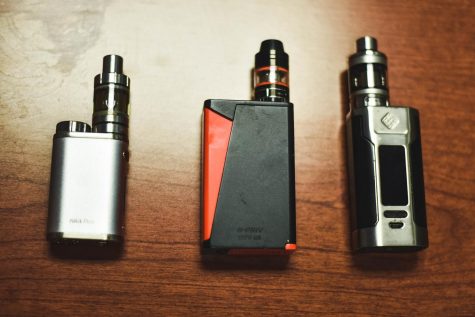Clearing the air
A special report on teens and vaping
January 25, 2019
From vapor clouds and the frequent smell of sweet aromas wafting through the air, to empty cartridges in trash cans, it’s hard to miss the evidence of teenage vaping. With an estimated 11.7 percent of teenagers now using e-cigarettes, the numbers have been climbing among minors over the last few years, becoming a nationwide concern. Figures from the Centers for Disease Control and Prevention in November showed a 78 percent increase in vaping amongst high school students with more than 3.5 million high school and middle school students using e-cigs.
Now, the Food and Drug Administration could take steps to remove e-cigarettes from the market.
“I’ll tell you this,” FDA Commissioner Dr. Scott Gottlieb said at a meeting recently. “If the youth use continues to rise, and we see significant increases in use in 2019, on top of the dramatic rise in 2018, the entire category will face an existential threat.”
In this special report, Wingspan explores why some teens use e-cigarettes, the potential dangers of vaping, and the consequences of on campus use.
Teenage fad or cure for smoking?
According to a CDC report from 2018, 20.8 percent of high school students and 4.9 percent of middle school students admitted to using e-cigarettes within 30 days of the survey. Most recently, a December 2018 press release from the National Institutes of Health reported that 37.3 percent of American high school seniors claimed to have vaped in the past year, up from 27.8 percent in 2017.
“The type of people who vape, it could literally be anyone, people in AP classes, people in on-level classes, people who are super nice,” student John Smith* said. “It could literally be anyone.”
Student Hannah Phillips* attributes her vaping to trying it once because “everyone was doing it” and never had the intention of doing it habitually.
“I found that it’s really kind of like an exciting thing to do, but at the same time I knew the dangers of it and how it could mess up your lungs and you can get lipid pneumonia and nicotine poisoning and all of that,” Phillips said. “It was just exciting to do something you’re not supposed to do.”
The device of choice among high schoolers is overwhelmingly a “JUUL”, the name the e-cigarette produced by the company of the same name. The company holds 70.5 percent of the e-cigarette market share with the costs of vaping adding up.
“I paid $40 for mine. It just depends who you’re buying it from,” Smith said. “From the website, a JUUL starter kit, $50 comes the with the charger, the JUUL itself and four pods. Which will last you if you’re a heavy vaper, like a week. But people upcharge you a lot.”
Popularized by its affordability, sleek appearance, and durability, JUUL was founded in 2015. According to its website, the company claims it’s product is “for adult smokers looking for a genuine alternative to smoking cigarettes”.
The use of e-cigarettes as a tool for adults to wean off of cigarette is recognized by Tylar Manning, a former Army combat medic and employee of Vapor Labs in Frisco.
“For me [what is attractive about vaping] is nicotine,” Manning said. “I did nine years in the Army, I did two packs of reds [Marlboro cigarettes] a day, it was a very stressful environment, now I’m going to college at 27 years old. Vaping for me is nicotine in its purest form, which is a stimulant, same as caffeine. I don’t smoke cigarettes anymore, period.”
* student names have been changed to protect their identity
Health risks and an unclear future
Regardless of its intended purpose, vaping has infiltrated the high schools of America. Todd Orme, CEO of Waterford Academy, a Richardson-based program for youth struggling with addiction in Richardson, sees this on a daily basis.
“It’s just like kids who smoke weed,” Orme said via phone call. “They get in this pattern of buying it, smoking it, buying it, selling it, it consumes their lifestyle. Fortunately, like most kids in high school don’t understand, the law in Texas doesn’t allow them to have e-cigarettes or vapes, they’re underage, it’s illegal. Kids will run the risk of getting a ticket and a fine.”
Although vaping does not involve tobacco, the presence of nicotine in e-cigarette liquid, or vape juice, leaves many becoming addicted nonetheless.
“The brain is a very, very delicate organ, and kids subject their brains to lots of chemicals,” Orme said. “Where vaping comes into play, based on my experience, is kids are vaping mostly nicotine which, in lieu of smoking cigarettes. What we find is that kids will find ways to get into vape shops, buy their vapes, buy their oil and basically puff away [and] it’s part of their addictive process.”
Specialists and those who vape alike have varying thoughts on whether vaping can be used effectively to wean off other substances or if it serves as a gateway to use of other substances.
“I don’t think I’d go to the concept of saying [vaping] is a gateway, if you’re to ask me, I firmly believe that smoking marijuana is a gateway to other drugs, especially over prolonged use,” Orme said. “I strongly believe that vaping is associated with smoking weed and other substances because of this pattern of behavior, being around people who do it.”
The e-juice in a JUUL is supplied by a cartridge referred to as a JUULpod. According to its website, “one JUULpod is approximately equivalent to 1 pack of cigarettes or 200 puffs. Each JUULpod contains 0.7mL with 5% nicotine by weight.”
This is alarming to some medical professionals such as Stanford University professor of pediatrics Bonnie Halpern-Felsher, who studies nicotine, stating, “[the nicotine content] is much higher than what we’re seeing in conventional e-cigs. It’s a tremendous amount.”
Besides the addictive properties of vaping, a lack of studies on its long term effects leaves more questions than answers regarding its safety.
“I think there are different levels of what’s in vaping liquids, and the contents of what’s in these vaping liquids is still unknown, as to what harmful effects they may have,” campus nurse Emily Mikeska said. “They are advertised as not being as harmful as cigarettes, but I don’t know if we could truly say that.”
One concern of using e-cigarettes is popcorn lung, defined by the American Lung Association as “a scarring of the tiny air sacs in the lungs resulting in the thickening and narrowing of the airways” that can cause “coughing, wheezing and shortness of breath, similar to the symptoms of chronic obstructive pulmonary disease (COPD).”
“Even though we know that diacetyl causes popcorn lung, this chemical is found in many e-cigarette flavors,” wrote the editorial staff of the ALA. “It is added to ‘e-juice’ liquid by some e-cigarette companies to complement flavorings such as vanilla, maple, coconut and more.”

In fact, researchers at Harvard University found that 39 of 51 e-cigarette brands contained diacetyl. The study also found two similarly harmful chemicals—2,3 pentanedione and acetoin—present in 23 and 46 of the 51 flavors it tested. Roughly 92 percent of the e-cigarettes had one of the three chemicals present.
Another major concern is the leaking of toxic metals from some e-cigarette coils, uncovered by the John Hopkins Bloomberg School of Public Health in a February study.
“The scientists examined e-cigarette devices owned by a sample of 56 users,” wrote the JHBPH. “They found that significant numbers of the devices generated aerosols with potentially unsafe levels of lead, chromium, manganese and/or nickel. Chronic inhalation of these metals has been linked to lung, liver, immune, cardiovascular and brain damage, and even cancers.”
Study senior author Ana María Rule, PhD, MHS stressed the significance of the findings in the report: “It’s important for the FDA, the e-cigarette companies and vapers themselves to know that these heating coils, as currently made, seem to be leaking toxic metals—which then get into the aerosols that vapers inhale.”
JUUL has topped the headlines of major news outlets on numerous occasions this school year, largely by unleashing the ire of FDA Commissioner Scott Gottlieb. Proposed changes in November by Gottlieb sought to make it more difficult to obtain candy and fruit flavored juice pods he claims to be the “center of the epidemic”.
In response to Gottlieb’s proposed changes, JUUL removed mango, fruit, creme, and cucumber flavors from stores. The brand also deleted its Facebook and Instagram accounts and halted the constant flow of promotional tweets on its Twitter account, after accusations from the FDA of encouraging the use of their products by youth.
As the future of the company remained unclear, cigarette giant Altria purchased 35 percent of the company in December 2018, increasing the value of JUUL to $38 billion. The move takes the vaping enterprise to a higher value than companies like SpaceX and Airbnb, ensuring that their popular e-cigarettes are likely here to stay.
Consequences on campus
Beyond the health concerns and trends of vaping, there is also the reality that minors vaping is simply illegal and the practice is never allowed on FISD campuses.

A collection of confiscated e-cigarettes, JUULpods and a charging USB connecter lie on the desk of campus Student Resource Officer Glen Hubbard.
“Don’t do it here, because if you get caught, you’re going to get a citation for it or a court referral,” campus student resource officer Glen Hubbard said. “You could get some ISS, maybe an out of school suspension, your parents have to get contacted, all sorts of things. I can’t curb behavior, so much as [students] wanting to do it, but I suggest not doing it here at school.”
After hundreds of vapes were collected during the 2017-2018 school year, campus administration returned from the summer break with a system of stricter punishments as follows: For a first offense, students receive an in-school suspension (ISS), a warning from officer Hubbard, and their guardians are contacted.
For a second offense, vaping yields a two day ISS, a citation from officer Hubbard, and a drug prevention class. A third offense brings three days of ISS, three days of an out-of-school suspension (OSS), and another citation. Fourth offenses yield the same punishment but also the possibility of being sent to the SOC, the district’s Student Opportunity Center.
“Last year, we didn’t put the SOC in place as far as looking at sending a kid to the SOC and then also we just did ISS, we didn’t do so this year, we included the OSS, included SOC,” campus assistant principal Jason Harris said. “I think you’re having a lot of kids that are just you know, falling to peer pressure with ‘I want to see what it’s like and so forth.’ I think that’s why we see such an increase.”
Harris views the new policy as in the best interest of students’ health through further discouraging the use of vapes on campus.
“We’re concerned about the safety of the students, so we will do what we can to help hopefully decrease when it takes place at Liberty High School,” Harris said. “The importance [of a strict anti-vaping policy] is for it to be used as a deterrent. If you are thinking about vaping on campus that hopefully you know this is the consequences are pretty harsh that you’ll reason with yourself and say ‘you know what I better not chance it because an AP, teacher, a staff member could walk in that restroom door in any second now and I’m not being the one getting caught’.”
The new enforcement policy could be working as Hubbard reports seeing a lull in the amount of vaping.
“At the beginning of the year it was pretty bad, there wasn’t any change. I was still doing it the same way I handled it: first time you get a warning the second time you get a citation,” Hubbard said. “They were still given the school consequences for having the possession on a vape or being caught vaping, as far as recently it’s calmed down a little bit.”
The recent pattern change noticed by Hubbard coincided with JUUL’s move to decrease the availability of certain flavors in stores.
“I think the removal some of the flavors of the JUULpods, I think that slowed it down by pushing it more towards the traditional juice type vaping,” Hubbard said. “That’s a little bit harder than [to get] and that’s not as prevalent so I haven’t written a ticket for one of those in a month or so.”
Many students who vape continue to ignore criticism and warnings from school administrators turning a blind eye to potential health implications.
“I vape because it’s fun I guess. It gives me something to do. Doing it with my friends, you get to meet a lot of people,” Smith said. “[Negative effects] kind of concern me. I’m not planning on doing it for a long time and I’m shortening my use, so I’m not doing it enough to where it would permanently harm me.”
Although students such as Smith may not fully recognize the potential consequences of vaping, there’s no gray area when it comes to the school’s perspective.
“I don’t think students realize how big of a deal it is; even if it’s non-nicotine, they don’t think they’re doing anything wrong, they don’t realize the implications of it,” assistant principal Stacy Whaling said. “The fact that even if there was something wrong with it, it’s still illegal for them to have it, because you can’t be under 18. We always confiscate the devices.”

